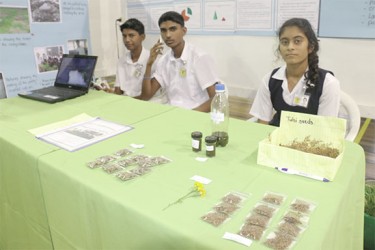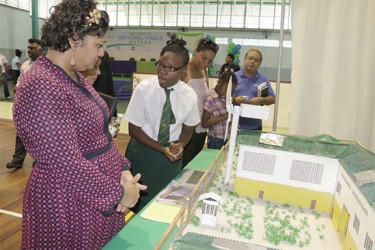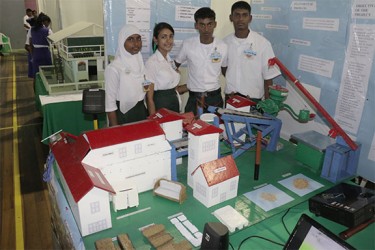By Sharda Bacchus
Using plants to repel mosquitoes and arrest the spread Chikungunya was among the solutions that took centre stage when the finals of the Sagicor Visionaries Challenge kicked off yesterday.
On the first of two days of competition, over 35 projects were showcased for judgment yesterday at the Cliff Anderson Sports Hall.
The competition requir-es students from participating secondary schools to solve a problem affecting their school or community by developing effective, innovative and sustainable solutions using different models through Science, Technology, Engineering and Mathematics (STEM).
Minister of Education Priya Manickchand, who officially opened the finals, said in her brief remarks that although the competition aimed at establishing solutions to problems, it also aided the students in attaining better grades at Caribbean Secondary Edu-cation Certificate (CSEC) examinations, where an increase in overall Grades 1 to 3 passes has been recorded.
She added that it takes a lot of effort to achieve such results and she encouraged the students to continue along this road before they began their presentations.
The students of the Skeldon Line Path Secondary School proposed a biological control to stop the spread of the mosquito-borne disease Chikungunya. Student Tasha Jailall told Stabroek News that the leaves of the marigold and tulsi plants can be boiled to make a brew that can be applied to the skin to repel mosquitoes. She added that not only can the brew be applied to the skin to avoid mosquito bites but by growing the two plants in yard spaces persons can keep mosquitoes away.

Jailall said that the school came up with the idea since Chikungunya remains a threatening disease and has claimed some lives although its spread could have been avoided by applying the simple solution.
The Richard Ishmael Secondary School, which is beset daily by power outages, proposed making a multi solar energy saving device. They depict a model of the school with a wind turbine and the solar panels visible. According to student Aba Crawford, the school is located three corners away from the sea shore and they decided to use a wind turbine to convert the wind into electricity and also to use solar panels to get energy from the sun, making electricity always accessible to the school.
The students of the Abram Zuil Secondary School presented on their “paddy husk particle board” project, which was prompted by smoke and air pollution that affect residents of their community due to the burning of the rice husk. The students seek to reduce the carbon dioxide and other pollutants emitted into the atmosphere from burning the husk in the open and also to utilise the material to manufacture low cost, durable particle boards, since the cost for woods used for construction, such as Crabwood and Silverbali, is very high.
Other schools that presented yesterday included Queen’s College, which fielded several projects, including developing an intranet for the students and staff; using the byproducts of fast food for fuel; using honey to make food products with a longer shelf life; and the use of Soursop for the health benefits.
Other schools taking part yesterday included Diamond Secondary School, the Bishops’ High School, St. Rose’s High, St. Stanislaus College, St. Joseph High, and Christ Church Secondary.
The competition will continue today and the winning school go on to represent Guyana at the regional competition in Tampa, Florida next July.






